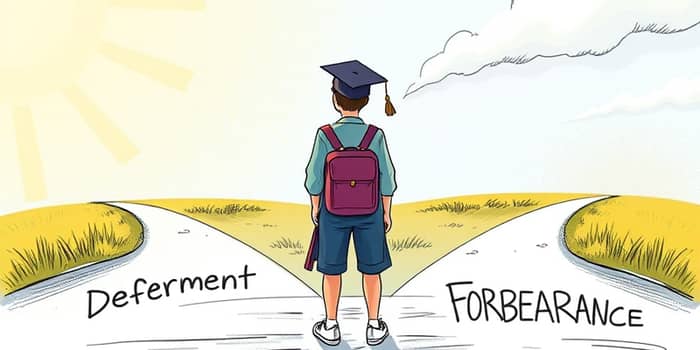Deciding between deferment and forbearance can feel overwhelming when you’re struggling to make student loan payments. Understanding the nuances of each option will empower you to take control of your financial future.
Overview of Student Loan Deferment and Forbearance
Student loan deferment and forbearance both offer temporary relief when you can’t afford your monthly payments. They pause or reduce payments, but they differ in interest accrual, eligibility, and duration.
Deferment is a formal agreement between you and your loan servicer that suspends payments under specific conditions. By contrast, forbearance is often a discretionary arrangement, granted at your servicer’s approval based on demonstrated hardship.
Understanding Deferment
A temporary pause in loan payments is the hallmark of deferment. It applies when you meet predefined criteria, such as full-time school enrollment, unemployment, economic hardship, military service, or undergoing medical treatment.
During deferment, no interest accrues on subsidized loans and Perkins loans, leaving your principal balance unchanged. However, for all other federal loans and private loans, interest continues to accumulate, potentially increasing your total balance at the end of the deferment period.
Eligibility for deferment hinges on your situation. Typical qualifying events include:
- Enrollment in school at least half-time
- Dislocated worker status or economic hardship
- Civilian post-active duty
- Medical or military service
The duration of deferment varies by type. For in-school deferment, it lasts as long as you remain enrolled at least half-time. Economic hardship deferment can extend up to three years, while other categories may offer unique timeframes. You must submit the correct form for your deferment category, and your loan servicer must grant deferment if you’re eligible and have available time.
Understanding Forbearance
Forbearance offers temporary relief during financial challenges by reducing or suspending payments for a defined period. It is available when you don’t qualify for deferment or need immediate assistance due to unexpected hardship.
Unlike deferment, interest accrues on all loans during forbearance. At the end of the forbearance period, your servicer may capitalize this accrued interest, adding it to your principal balance and increasing future payments.
Eligibility is more flexible. You don’t need a specific qualifying event, though some forbearance categories—like mandatory forbearance—require certain circumstances such as participation in government or medical internship programs.
Forbearance typically lasts up to twelve months, but you can request additional periods if still eligible. Approval rests largely with your loan servicer, who evaluates your financial situation on a case-by-case basis. You’ll complete a single general forbearance form for most requests.
Key Differences Between Deferment and Forbearance
Choosing Between Deferment and Forbearance
Selecting the right option depends on your loan type, financial outlook, and long-term goals. Deferment is often the superior choice for those holding subsidized federal loans or Perkins loans because it prevents interest from accumulating during the relief period.
However, if you don’t meet deferment criteria or need immediate relief, forbearance can provide critical breathing room. Keep in mind that interest will continue to accrue, which may cost you more over time.
Consider these factors before deciding:
- Whether your loan is subsidized or unsubsidized
- Your current and projected income
- Your ability to resume full payments in the future
Alternative Options to Consider
If deferment or forbearance isn’t ideal, explore these alternatives for long-term sustainability:
- Income-driven repayment plans adjust payments based on earned income and family size, capping monthly obligations.
- Student loan refinancing with a private lender can lower interest rates but may eliminate federal benefits such as forgiveness and income-driven plans.
- Public Service Loan Forgiveness programs for qualifying government or nonprofit employees after ten years of payments.
Application and Approval Process
Applying for deferment or forbearance requires thorough preparation to ensure timely approval and minimal headaches.
Gather supporting documentation such as enrollment verification, hardship statements, or military orders. Having this evidence ready shows your servicer that you meet the required criteria.
Maintain open communication with your loan servicer. Ask detailed questions about:
- Required documentation and forms
- Processing timelines and potential delays
- Impacts on interest accrual and capitalization
Once approved, track deadlines carefully to request extensions or transition to alternative repayment options before relief periods expire.
By understanding the distinctions between deferment and forbearance, evaluating your financial situation, and considering all available relief programs, you can make an informed choice that safeguards your credit and reduces long-term costs. Taking action early and staying organized are your keys to navigating student loan repayment challenges with confidence.
References
- https://studentaid.gov/help-center/answers/article/difference-between-deferment-and-forbearance
- https://www.nerdwallet.com/article/loans/student-loans/student-loan-deferment-forbearance
- https://www.citizensbank.com/learning/student-loan-deferment-vs-forbearance.aspx
- https://www.bankrate.com/loans/student-loans/deferment-or-forbearance-student-loans/
- https://www.abainsurance.com/resource-center/education-center/deferment-vs-forbearance/
- https://www.citizensbank.com/learning/student-loan-forbearance.aspx
- https://www.lendingtree.com/student/student-loan-deferment-forbearance/
- https://www.citi.com/personal-loans/learning-center/basics/loan-deferment-vs-loan-forbearance










